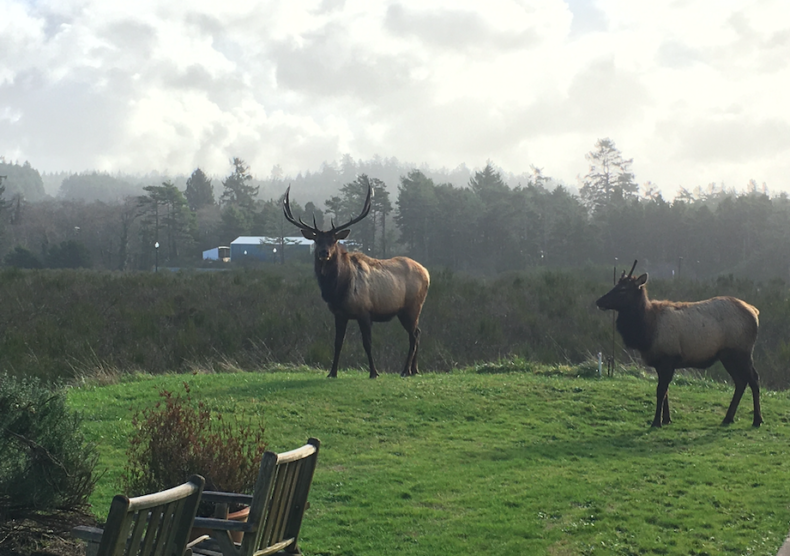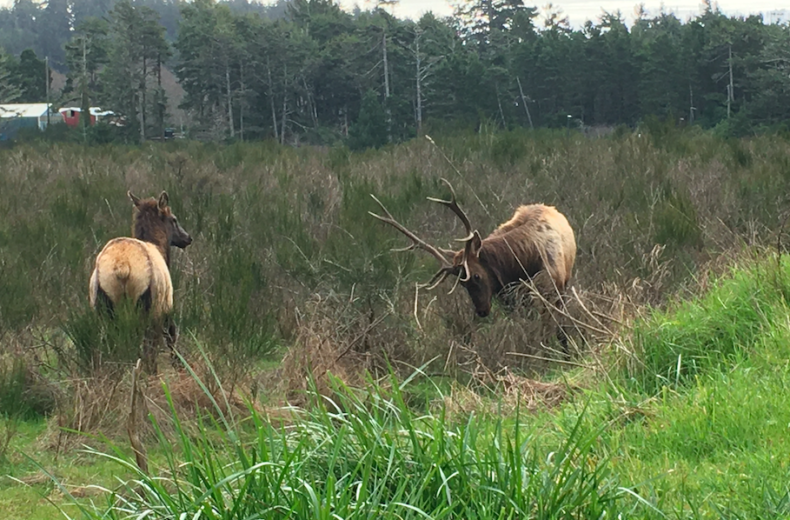
We first saw the elk in September. Our route to the Wilder forest passed the Yaquina Bay, and there, between the road and mudflats, was an antler rack we initially mistook for a willow tree.
Our neighbor said it was likely that hunters chased them out of the hills. That they were a smart herd.
We saw them again in October, this time eating pickleweed behind the Hatfield Marine Science Center. They lifted their heads and eyed us briefly. A couple nights later, on the same path, we nearly walked into the bull before he raised his head. For no tactical reason other than that it felt vaguely respectful, we pulled our headlamps off and waved them on the ground as we backed away.
Shortly after, Hatfield security hazed them off the grounds, and the herd reemerged in the field outside our place.
***
The herd quickly became a sort of glue for the neighborhood, binding us in our disparate connections to them. One boy watched the elk through his window with a handheld spotting scope for hours at a time. My own connection deepened a couple weeks after they’d arrived. Grabbing a sip of water at 1 am, I looked out the window at what I thought was Scots broom shifting in the wind. Then the bull turned and I saw his side glow in the lamplight before he moved off into the field.
That night the bull crossed from a spectacle to a presence, and I began to watch and listen to the herd more intently. On the mornings between storms I sat on the edge of the field, a hundred square yards of sandy soil that abuts mossy dunes of shore pine. A soundscape would materialize—the munching, mewing, clacking of antler on antler. Grunts and huffs, the squeak of a car slowing to look. It was not just me who needed their company. Others wanted to get in touch, to view natural beauty at a time when “nature,” in the form of a deadly virus, was showing us our fragility.
***
We named the seven of them. There was Bull, whose great antler rack branched five times, dark at the base and blond at the tips. There was Queen, who had a plump vein in her cheek, the thick fur behind her head parted neatly in the middle. Spike was a rowdy male whose foot-long antlers kinked at the top. Little Nubs had a mismatched pair of antler nubs. There was Cinnamon, who seemed to be Spike’s lady friend; Baby, a calf whose coat was rock gray; and a mysterious cow we named Other One.
As they became familiar we did our best not to take them for granted. It helped that their circuit wasn’t legible to us—they would disappear for a day or two, and we’d hear about them showing up on the other side of the 101. One girl claimed they used the crosswalk. Regardless, their return always felt like a gift. One blustery night I saw Bull standing alone, facing away from the wind, statue-still. I felt awe at his unknowable freedom, like a wave moving across the sea, hints of the infinite under stormy skies.
I learned they could leap like deer, that Spike liked to chase the cows, that he and Bull would dip their heads and press antlers. By early January their coats had thickened, resembling in buff color and shagginess the fur of grizzly bears. I once saw Spike lick one of Little Nubs’s nubs. I also saw him jab a cow.
One morning Spike sniffed Cinnamon’s rump as she walked away. He peed, then tried to mount. Though her tiny tail was up she kept her distance. That night a storm ripped the door off the greenhouse. They disappeared for a couple days.
A state biologist at an outdoor bar said they were a “desired species.” A neighbor said they looked “ominous” in the misty field. One of my students pulled over in her truck while they were out. “Man, that’s amazing,” she said. A skateboarder said he’d been stopped by Bull, who squared up against him. I watched in frustration as a woman tossed carrots.
I sent a picture of Bull to a city friend.
“That’s real?” he asked.
***
The elk were a mirror in which we glimpsed our relationships to wildness. We had become so detached from wild animals that their “intrusion” touched something hidden, an elemental signal so faint we barely recognized it, though we sensed we needed to listen.
I walked the field one day when they were gone. A sleeping bag was torn to shreds. The Scots broom—its base thick as the fat end of a baseball bat—had been fully uprooted where it wasn’t toppled, split and shredded. A water jug was riddled with antler punctures. Two-foot deep scrapes in the sandy soil were everywhere; a coil of fishing rope was frayed. Grenade-shaped piles of poop lay among the mown grass. The elk began to make appearances in my dreams.
We woke to our first frost one morning in early February. It was strange and touching to watch Queen start across the street towards the Pioneer cemetery, a sandy hill with a few slumping headstones among roots of shore pine and spruce. She picked her way up the hill as sunrise spread above the Coast Range.
A friend texted to say Bull would likely be dropping antlers soon, to grab them if we saw them. The Police Tip of the Week reminded drivers to be aware that elk came down out of the mountains this time of the year. I saw Queen sneeze. The second to last morning I watched tufts of fur float in the breeze as Bull and Spike did their push dance. That afternoon the rain came and the herd sat in a meadow near the road, except for Spike, who shook off a cloud of water as I passed.
The last night I talked to someone who claimed Bull gored a dog to death. He’d heard it secondhand, suspected a game of telephone was afoot, but nonetheless the rumor was circulating.

***
Shortly after the first truck rolled up came another with a horse trailer. Bull watched as a man and a woman entered the field wearing latex gloves. A white suburban with Just Married flags slowed as it passed. I put on shoes and hurried out.
While my brain sensed what was happening, my heart had yet to catch up. There were state trooper trucks now, nearly a dozen people in the field. I walked over as they were carrying the tarp. That’s when it hit.
After unloading the first tranquilized elk in the trailer they returned to the field. I asked what was going on, and someone said they were moving them, that the herd had been deemed aggressive.
I hurried back to the apartment. We got binos on the remaining five and realized Little Nubs was one of the taken. I had to stop looking when they shot the next one—it was hard to watch the frantic movements of a herd that for months had been graceful even in their excited play, now knocking into one another in confusion.
***
The whole thing had gone down in under an hour. They’d gotten two, one of their darts bouncing off the bone of another, and would have to return for the remaining elk.
There was a light breeze, the sun filtering through clouds. I thought about game management, the difficult work of tending the fragile borders between us and what we call the wild. With the removal of the elk came the removal of randomness. The wordless conversations ended, the mysterious bonds gluing strangers and friends shipped off.
I last saw them sitting in a clearing near a wall of pines. Through binoculars I watched Queen chew sadly. After a few minutes I realized there was nothing in her mouth, and wondered if she’d been the shot one, if the gumming was a sort of reaction. I had never noticed how bulbous her nose was, the dark crosshatched markings at its end, nor the lovely ring of light fur around Spike’s eye.
I later heard they weren’t going to take Bull, that he would wander by himself until whatever happened next.